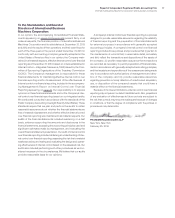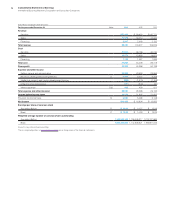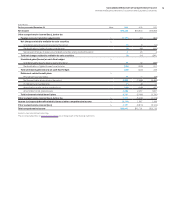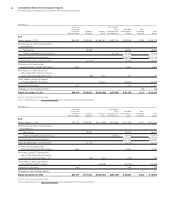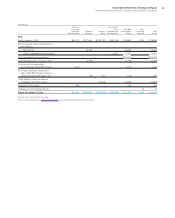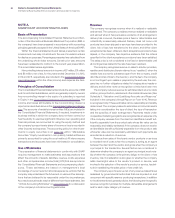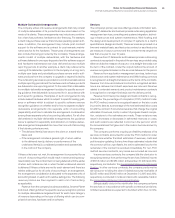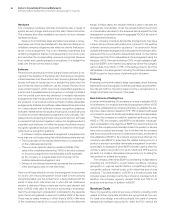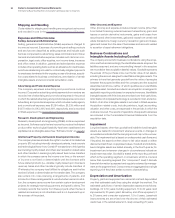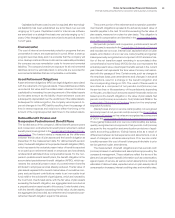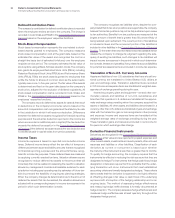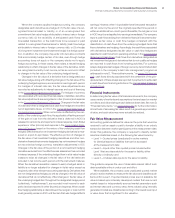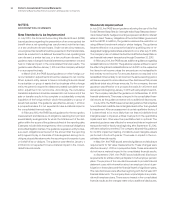IBM 2013 Annual Report Download - page 88
Download and view the complete annual report
Please find page 88 of the 2013 IBM annual report below. You can navigate through the pages in the report by either clicking on the pages listed below, or by using the keyword search tool below to find specific information within the annual report.
Notes to Consolidated Financial Statements
International Business Machines Corporation and Subsidiary Companies
87
deferred and recognized based on the labor costs incurred to date,
as a percentage of the total estimated labor costs to fulfill the con-
tract. Certain eligible, nonrecurring costs incurred in the initial
phases of outsourcing contracts are deferred and subsequently
amortized. These costs consist of transition and setup costs related
to the installation of systems and processes and are amortized on
a straight-line basis over the expected period of benefit, not to
exceed the term of the contract. Additionally, fixed assets associated
with outsourcing contracts are capitalized and depreciated on a
straight-line basis over the expected useful life of the asset. If an
asset is contract specific, then the depreciation period is the shorter
of the useful life of the asset or the contract term. Amounts paid to
clients in excess of the fair value of acquired assets used in out-
sourcing arrangements are deferred and amortized on a straight-line
basis as a reduction of revenue over the expected period of benefit
not to exceed the term of the contract. The company performs peri-
odic reviews to assess the recoverability of deferred contract
transition and setup costs. This review is done by comparing the
estimated minimum remaining undiscounted cash flows of a contract
to the unamortized contract costs. If such minimum undiscounted
cash flows are not sufficient to recover the unamortized costs, an
impairment loss is recognized.
Deferred services transition and setup costs were $2,402 million
and $2,424 million at December 31, 2013 and 2012, respectively.
Amortization of deferred services transition and setup costs was
estimated at December 31, 2013 to be $812 million in 2014, $612
million in 2015, $400 million in 2016, $247 million in 2017 and $332
million thereafter.
Deferred amounts paid to clients in excess of the fair value of
acquired assets used in outsourcing arrangements were $89 million
and $51 million at December 31, 2013 and 2012, respectively. Amor-
tization of deferred amounts paid to clients in excess of the fair value
of acquired assets is recorded as an offset of revenue and was
estimated at December 31, 2013 to be $27 million in 2014, $27 million
in 2015, $8 million in 2016, $5 million in 2017 and $22 million there-
after. In situations in which an outsourcing contract is terminated,
the terms of the contract may require the client to reimburse the
company for the recovery of unbilled accounts receivable, unamor-
tized deferred costs incurred to purchase specific assets utilized in
the delivery of services and to pay any additional costs incurred by
the company to transition the services.
Software Costs
Costs that are related to the conceptual formulation and design of
licensed software programs are expensed as incurred to research,
development and engineering expense; costs that are incurred to
produce the finished product after technological feasibility has been
established are capitalized as an intangible asset. Capitalized
amounts are amortized on a straight-line basis over periods ranging
up to three years and are recorded in software cost within cost
of sales. The company performs periodic reviews to ensure that
unamortized program costs remain recoverable from future revenue.
Costs to support or service licensed programs are charged to soft-
ware cost within cost of sales as incurred.
The company capitalizes certain costs that are incurred to pur-
chase or to create and implement internal-use software programs,
including software coding, installation, testing and certain data
conversions. These capitalized costs are amortized on a straight-
line basis over periods ranging up to two years and are recorded
in selling, general and administrative expense.
Product Warranties
The company offers warranties for its hardware products that gener-
ally range up to three years, with the majority being either one or
three years. Estimated costs for warranty terms standard to the
deliverable are recognized when revenue is recorded for the related
deliverable. The company estimates its warranty costs standard
to the deliverable based on historical warranty claim experience
and estimates of future spending, and applies this estimate to the
revenue stream for products under warranty. Estimated future costs
for warranties applicable to revenue recognized in the current
period are charged to cost of sales. The warranty liability is reviewed
quarterly to verify that it properly reflects the remaining obligation
based on the anticipated expenditures over the balance of the
obligation period. Adjustments are made when actual warranty claim
experience differs from estimates. Costs from fixed-price support
or maintenance contracts, including extended warranty contracts,
are recognized as incurred.
Revenue from separately priced extended warranty contracts
is initially recorded as deferred income and subsequently recog-
nized on a straight-line basis over the delivery period. Changes in
deferred income for extended warranty contracts, and in the warranty
liability for standard warranties, which are included in other accrued
expenses and liabilities and other liabilities in the Consolidated
Statement of Financial Position, are presented in the following tables:
Standard Warranty Liability
($ in millions)
2013 2012
Balance at January 1 $ 394 $ 407
Current period accruals 346 394
Accrual adjustments to reflect actual experience 22 (15)
Charges incurred (387) (392)
Balance at December 31 $ 376 $ 394
Extended Warranty Liability (Deferred Income)
($ in millions)
2013 2012
Balance at January 1 $ 606 $ 636
Revenue deferred for new extended
warranty contracts 305 268
Amortization of deferred revenue (324) (301)
Other* (8) 4
Balance at December 31 $ 579 $ 606
Current portion $ 284 $ 289
Noncurrent portion 295 317
Balance at December 31 $ 579 $ 606
* Other consists primarily of foreign currency translation adjustments.


